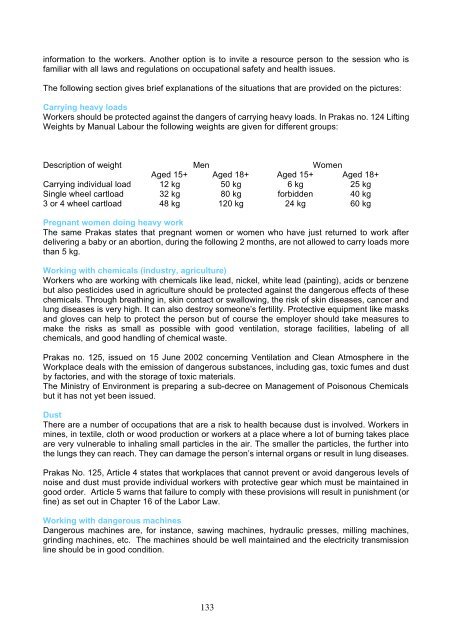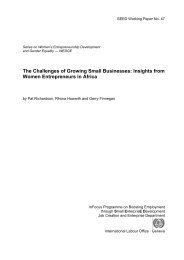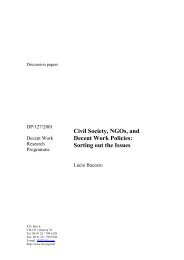manual: women workers' rights and gender equality - International ...
manual: women workers' rights and gender equality - International ...
manual: women workers' rights and gender equality - International ...
You also want an ePaper? Increase the reach of your titles
YUMPU automatically turns print PDFs into web optimized ePapers that Google loves.
information to the workers. Another option is to invite a resource person to the session who is<br />
familiar with all laws <strong>and</strong> regulations on occupational safety <strong>and</strong> health issues.<br />
The following section gives brief explanations of the situations that are provided on the pictures:<br />
Carrying heavy loads<br />
Workers should be protected against the dangers of carrying heavy loads. In Prakas no. 124 Lifting<br />
Weights by Manual Labour the following weights are given for different groups:<br />
Description of weight<br />
Men<br />
Women<br />
Aged 15+ Aged 18+ Aged 15+ Aged 18+<br />
Carrying individual load 12 kg 50 kg 6 kg 25 kg<br />
Single wheel cartload 32 kg 80 kg forbidden 40 kg<br />
3 or 4 wheel cartload 48 kg 120 kg 24 kg 60 kg<br />
Pregnant <strong>women</strong> doing heavy work<br />
The same Prakas states that pregnant <strong>women</strong> or <strong>women</strong> who have just returned to work after<br />
delivering a baby or an abortion, during the following 2 months, are not allowed to carry loads more<br />
than 5 kg.<br />
Working with chemicals (industry, agriculture)<br />
Workers who are working with chemicals like lead, nickel, white lead (painting), acids or benzene<br />
but also pesticides used in agriculture should be protected against the dangerous effects of these<br />
chemicals. Through breathing in, skin contact or swallowing, the risk of skin diseases, cancer <strong>and</strong><br />
lung diseases is very high. It can also destroy someone’s fertility. Protective equipment like masks<br />
<strong>and</strong> gloves can help to protect the person but of course the employer should take measures to<br />
make the risks as small as possible with good ventilation, storage facilities, labeling of all<br />
chemicals, <strong>and</strong> good h<strong>and</strong>ling of chemical waste.<br />
Prakas no. 125, issued on 15 June 2002 concerning Ventilation <strong>and</strong> Clean Atmosphere in the<br />
Workplace deals with the emission of dangerous substances, including gas, toxic fumes <strong>and</strong> dust<br />
by factories, <strong>and</strong> with the storage of toxic materials.<br />
The Ministry of Environment is preparing a sub-decree on Management of Poisonous Chemicals<br />
but it has not yet been issued.<br />
Dust<br />
There are a number of occupations that are a risk to health because dust is involved. Workers in<br />
mines, in textile, cloth or wood production or workers at a place where a lot of burning takes place<br />
are very vulnerable to inhaling small particles in the air. The smaller the particles, the further into<br />
the lungs they can reach. They can damage the person’s internal organs or result in lung diseases.<br />
Prakas No. 125, Article 4 states that workplaces that cannot prevent or avoid dangerous levels of<br />
noise <strong>and</strong> dust must provide individual workers with protective gear which must be maintained in<br />
good order. Article 5 warns that failure to comply with these provisions will result in punishment (or<br />
fine) as set out in Chapter 16 of the Labor Law.<br />
Working with dangerous machines<br />
Dangerous machines are, for instance, sawing machines, hydraulic presses, milling machines,<br />
grinding machines, etc. The machines should be well maintained <strong>and</strong> the electricity transmission<br />
line should be in good condition.<br />
133

















